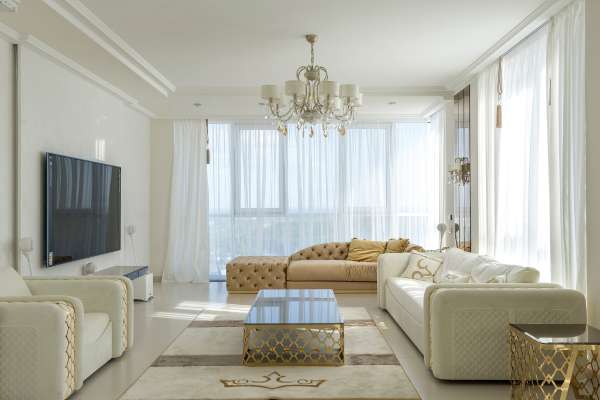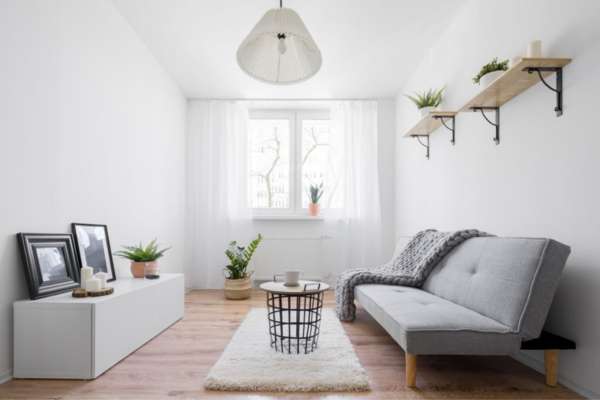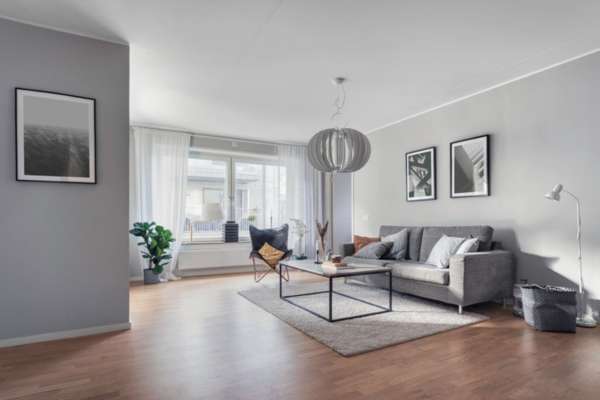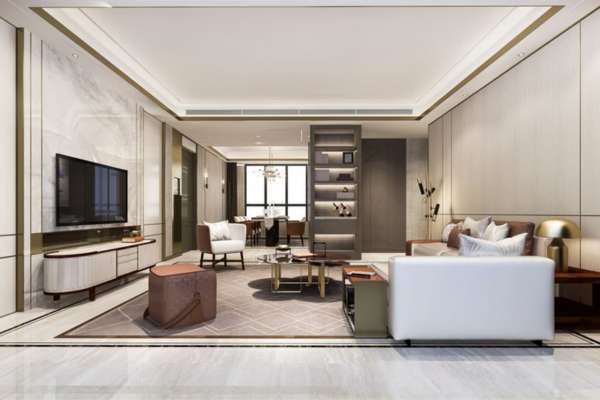Narrow Living Room Can Be A Challenge When It Comes To Arrange Furniture. However, By Following These Tips, You Can Create A Comfortable And Functional Space. First, Use The Room’s Natural Features To Your Advantage. For Example, If The Room Has A Short Wall On One Side, Place it Against That Wall To Maximize The Space. Also, Consider Using Tall Shelves Or Tables To Create More Storage Space. Finally, Use Accessories And Colors To Tie The Room Together.
1. Importance Of Arranging Furniture Properly

Arranging Furniture Properly Is Crucial For Any Living Space To Look Great And Feel Comfortable. It Can Be Challenging, Especially When The Living Is Narrow. However, With A Little Planning And Creativity, You Can Make Your Narrow Living Room Appear More Spacious And Cozy Than Ever Before.
The First Step In Arranging Furniture In A Narrow Living Room Is To Determine Its Focal Point. Typically, This Would Be The Tv Or Fireplace. Once You Have Identified The Focal Point, Arrange Your Seating Accordingly Around It. Consider Using Small-scale Armchairs Instead Of Bulky Sofas To Maximize Space Utilization Without Compromising Comfort.
Another Important Factor To Consider When Arranging In A Narrow Living Is Traffic Flow. Ensure That There Is Enough Walking Space Between The Pieces Of Furniture So That People Can Move Around Comfortably Without Bumping Into Anything.
2. Determine The Room’s Function

Are You Using This Room As A Formal Sitting Area Or Is It More For Casual Entertaining? Knowing How You Plan On Using The Space Will Help Guide Your Placement Decisions. If It’s A Formal Sitting Area, Consider Placing Two Armchairs Across From Each Other With A Coffee Table In Between. This Creates An Intimate Setting For Conversation.
On The Other Hand, If Your Narrow Living Is More For Casual Entertaining, Consider Creating Multiple Seating Areas Throughout The Space. Place A Sofa Along One Wall And Then Add Two Chairs Opposite It With A Small Table In Between. This Allows Guests To Sit And Chat While Still Being Able To See Everyone In The Room. Additionally, Adding Floor Cushions Or Ottomans Can Give Guests Additional Seating Options While Maintaining An Open Flow Throughout The Space.
3. Consider The Number Of People Using The Space

Arranging Furniture In A Narrow Living Can Be Quite Challenging, Especially If You Have Limited Space. However, With The Right Approach And Some Creativity, You Can Create A Functional And Comfortable Living That Meets Your Needs. One Essential Factor To Consider Is The Number Of People Using The Space. If You Frequently Entertain Guests Or Have A Large Family, Then You Need To Plan Accordingly.
Firstly, Start By Measuring Your Living Room’s Dimensions So You Know How Much Space You Are Working With. Then Choose Pieces That Are Appropriate For Your Requirements – If There Are Many People Using The Room At Once, Consider Buying Smaller Chairs Or Arranging Seating Into Multiple Areas So Everyone Has A Place To Sit Comfortably. Additionally, Opting For Multi-functional Pieces Such As Ottomans Or Benches With Storage Compartments Can Help Maximize Available Space While Providing Additional Seating Options.
4. Measure The Room And Furniture

This Will Help Ensure That You Are Maximizing Your Space And Creating A Functional Layout. Begin By Taking Accurate Measurements Of The Length And Width Of Your Living, Then Measure Each Piece Of Furniture You Plan To Use.
After Measuring, Create A Rough Sketch Or Floor Plan Of Your Living Room. This Will Give You An Idea Of How Much You Have To Work With And Where Each Piece Should Be Placed. When Arranging Furniture In A Narrow Living Space, It’s Important To Consider Traffic Flow And Allow For Enough Space For People To Move Around Comfortably.
Measuring The Length And Width Of Your Living Room. Take Note Of Any Doors, Windows, Or Architectural Features That May Impact Your Placement. Next, Measure Each Piece Of Furniture You Plan On Using In The Space. Make Sure To Account For Any Protruding Features Such As Arms Or Legs.
Once You Have All Of Your Measurements, Create A Scaled Drawing Of Your Living Room And All Of Its Contents. This Will Give You A Visual Representation That Can Help Guide Your Furniture Arrangement Decisions. Consider Creating Multiple Layouts Until You Find One That Maximizes Space While Also Providing Functional Seating Areas.
5. Measure The Furniture You Plan To Use

Arranging Furniture In A Narrow Living Can Be Challenging. But With Careful Planning, You Can Make The Most Of Your Space And Create An Inviting And Comfortable Environment. The First Step Is To Measure The Furniture You Plan To Use. Take Note Of Its Dimensions, Including The Height, Width, And Depth.
Next, Create A Floor Plan That Incorporates All Of Your Pieces. Determine Where Each Item Will Go And How It Will Fit Into The Space. Consider Leaving Some Open Areas For Traffic Flow And Visual Balance.
When Arranging Your Furniture, Think About Creating Zones Within The Room. For Example, You Could Designate One Area For Seating And Another For Storage Or Entertainment. Use Rugs Or Other Decorative Elements To Define These Zones And Add Visual Interest To Your Space. Finally, Experiment With Different Layouts Until You Find One That Works Best For Your Needs And Style Preferences.
6. Create A Floor Plan

Creating A Floor Plan For A Narrow Living Room Can Be Challenging, But With The Right Approach, You Can Make It Look Spacious And Inviting. The Key To Arranging In A Narrow Living Is To Create Zones That Serve Different Purposes. This Means That You Need To Divide Your Space Into Areas For Seating, Dining, Entertainment, And So On.
One Way To Achieve This Is By Using Area Rugs Or Lighting Fixtures To Define Each Zone. For Example, You Can Place A Rug Under Your Sofa And Coffee Table To Mark The Seating Area While Hanging Pendant Lights Over The Dining Table. Additionally, Consider Using Vertical Storage Solutions Such As Bookcases Or Shelves To Maximize Space Utilization And Avoid Cluttering Up The Room.
Another Way To Arrange Furniture In A Narrow Living Room Is By Creating Zones Within The Area. This Means Breaking Up The Space Into Different Sections Such As Seating Areas And Entertainment Areas.
7. Sketch A Floor Plan Of The Room

Arranging Furniture In A Narrow Living Room Can Be A Challenging Task. It Is Essential To Come Up With A Layout That Maximizes The And Provides An Inviting Atmosphere. One Of The Best Ways To Achieve This Goal Is By Sketching A Floor Plan Of The Room. A Floor Plan Allows You To Visualize Different Furniture Arrangements, Experiment With Various Layouts, And Find The Most Practical Solution For Your Space.
Creating A Floor Plan Is Measuring Your Living Dimensions Accurately. Use A Tape Measure Or Laser Ruler To Determine The Length And Width Of Your Room, As Well As Ceiling Height, Doorways, Windows, And Any Architectural Features That Could Affect Furniture Placement. Once You Have These Measurements On Hand, Draw Them On Graph Paper Or Use An Online Tool Like Roomsketcher Or Floorplanner To Create A Virtual Layout.
Measuring Your Living Room, Including The Length And Width Of Each Wall. Then, Draw Out A Scaled-down Version Of Your Space On Paper Using Graph Paper Or An Online Tool Like Roomsketcher. This Will Give You An Idea Of How Much Space You Have To Work With And Allow You To Experiment With Different Furniture Arrangements Without Having To Physically Move Anything Around.
8. Arrange Furniture To Scale On The Plan

Arranging Furniture In A Narrow Living Can Be Quite Challenging. However, With The Right Approach And Proper Planning, You Can Make The Most Of Your Space And Create A Functional Layout That Works For You. One Essential Step To Achieving This Is Arranging Your Furniture To Scale On The Plan.
Measuring Your Living Room Space And Drawing Up A Plan To Scale. This Will Give You An Idea Of How Much Floor Space You Have Available And Allow You To Experiment With Different Layouts Before Moving Any Furniture. When Arranging Yours, It’s Important To Consider Both Function And Style – Think About What Activities Take Place In The Room (e.g., Watching Tv, Entertaining Guests) And How Best To Accommodate Them While Still Maintaining A Cohesive Design Aesthetic.
When Arranging Your Pieces Of Furniture Within Your Plan Or Layout, Keep In Mind Their Scale And Proportion. Large Sofas Or Chairs Might Look Out Of Place In A Small Room While Smaller Chairs May Not Fill Out Larger Spaces Well Enough.
9. Place Furniture Strategically

Arranging Furniture In A Narrow Living Can Be A Challenging Task. However, With the Strategic Placement Of Furniture, You Can Create A Functional And Stylish Space That Maximizes The Limited Square Footage. Here Are A Few Hints And Deceives To Assist You With Organizing Your Furniture In The Most Ideal Way Conceivable.
Take Measurements Of Your Living Room To Ensure That The Furniture Pieces You Choose Fit Well In The. Then, Consider Using Multi-functional Pieces Such As Sleeper Sofas Or Ottomans With Storage To Save On Space. Place Larger Pieces Against Walls To Create An Illusion Of More Floor Space While Providing Ample Walking Room.
Arrange Seating Areas Around Focal Points Such As Fireplaces Or Tvs For A Cozy Feel. Use Area Rugs To Define Each Seating Area And Add Texture And Depth To Your Living Room.
10. Place The Largest Piece Of Furniture First

Arrange Furniture In A Narrow Living Room Can Be A Challenge. But With A Little Bit Of Planning And Creativity, It Is Possible To Create An Inviting And Functional Space. One Of The Most Important Things To Consider Is The Placement Of The Largest Piece Of Furniture – Typically The Sofa. This Often Sets The Tone For The Rest Of Your Layout.
When Designing Your Layout, Start By Measuring Your Space And Noting Any Obstacles Such As Doors Or Windows. Next, Consider How You Want To Use The – Will It Primarily Be For Watching Tv Or Entertaining Guests? Once You Have Determined This, Place Your Largest Piece Of Furniture Accordingly. In Most Cases, This Will Be A Sofa Or Sectional Placed Against One Wall.
Another Benefit Of Placing Your Largest Piece First Is That It Can Help You Avoid Overcrowding. If You Begin By Adding Smaller Items Like End Tables Or Lamps, It’s Easy To Get Carried Away And End Up With Too Much Clutter In Such A Small Area.
11. Use Furniture To Create Distinct Zones

Arrange Furniture In A Narrow Living Room Can Be Challenging, But There Are Ways To Make The Most Of The Space. One Effective Technique Is To Create Distinct Zones Using Furniture Placement. This involves Dividing The Room Into Separate Areas For Different Activities Such As Lounging, Dining, Or Entertainment.
Measure Your Living Room And Map Out How Much Space You Have To Work With. Next, Consider Your Lifestyle And How You Use Your Living Room. Do You Entertain Often? Do You Need A Workspace? Once You Have Identified Your Needs, Start Arranging Furniture Accordingly. For Example, Place A Sofa Against One Wall With An Accent Chair Angled Towards It To Create A Conversational Area For Entertaining Guests.
For Dining Areas, Choose A Table That Fits Comfortably In The Available Area And Add Chairs Or Benches Around It. Be Sure To Leave Enough Room For People To Move Around Easily Between The Furniture Pieces.
12. Use Lighting To Enhance Space

Lighting Is An Essential Aspect Of Interior Design That Can Make Or Break The Ambiance Of A. Proper Lighting Can Enhance The Look And Feel Of Any Room While Adding Depth And Dimension To It. In A Narrow Living, Lighting Becomes Even More Crucial As It Helps Create An Illusion Of Space.
To Make Your Narrow Living Appear Spacious, You Should Arrange Your Furniture In A Way That Creates Enough Space For People To Move Around Comfortably. Avoid Placing Too Much In The Middle Of The Room As It Will Only Make It Look Cluttered And Cramped. Instead, Arrange Your Furniture Along The Walls To Create An Open Area In The Center Of The Room.
Add Floor Lamps Or Table Lamps At Strategic Points Around The Room. These Will Not Only Provide Additional Light But Also Add Visual Interest And Height To Your Decor.
13. Use Decor To Add Height Or Length

Adding Height Or Length Through Decor Can Help Create The Illusion Of More Space And Make Your Room Look More Inviting. With A Few Simple Tricks, You Can Transform Your Narrow Living Into An Impressive And Comfortable One.
Using Vertical Decor Elements Is An Excellent Way To Add Height To Your Living Room. This Could Include Tall Floor Lamps, Bookshelves, Or Artwork Hung High On The Walls. By Drawing The Eye Upward, These Pieces Will Create A Sense Of Height In Your Space.
Selecting Furniture Pieces That Will Enhance Your Living Dimensions Rather Than Detract From Them. Look For Sleek And Minimalist Designs That Won’t Take Up Too Much Floor. Consider Placing Long Sofas Against One Wall To Elongate The Room; This Will Also Create A Natural Pathway Through The Center Of Your Living Area. If Possible, Opt For Furniture With Exposed Legs As They Give An Unobstructed View Of The Flooring Beneath – Creating An Airy Feel. Arrange Sofa And Loveseat In Small Living Room
14. Avoid Clutter And Unnecessary Items

A Clutter Can Feel Overwhelming And Make The Room Seem Smaller Than It Actually Is. To Create A Comfortable And Functional Living Area, Start By Decluttering The Space And Only Keeping Essential Items.
Consider The Arrange Furniture Layout In Your Narrow Living Room. To Maximize Space, Try Placing Your Sofa Against One Wall With Chairs Or End Tables On Either Side. This Will Create An Open Flow Throughout The Room While Still Providing Ample Seating For Guests. Additionally, You Could Opt For A Sectional Sofa Which Can Be Arranged In Various Ways Depending On Your Specific Needs.
Avoid Placing Furniture Directly Against The Walls As This Can Make Your Living Feel Cramped. Instead, Create Visual Interest By Placing Some Of Your Pieces At An Angle Or Using Floating Shelves To Display Decorative Items Without Taking Up Valuable Floor Space. Read More:- Other Post
Conclusion
In Conclusion, Arrange Furniture In A Narrow Living Room Can Be Difficult, But With A Little Creativity And Some Strategically Placed Objects, The Room Can Look Spacious And Comfortable. By Using Pieces That Are Both Versatile And Complementary, You Can Create A Space That Feels Like It Belongs To You. Try Grouping Items Together By Function (such As Seating, Storage, And Decoration) Or By Color. And If You Still Feel Cramped, Consider Investing In A Narrow Piece Of Furniture That Lets You Open Up The Room Significantly.
